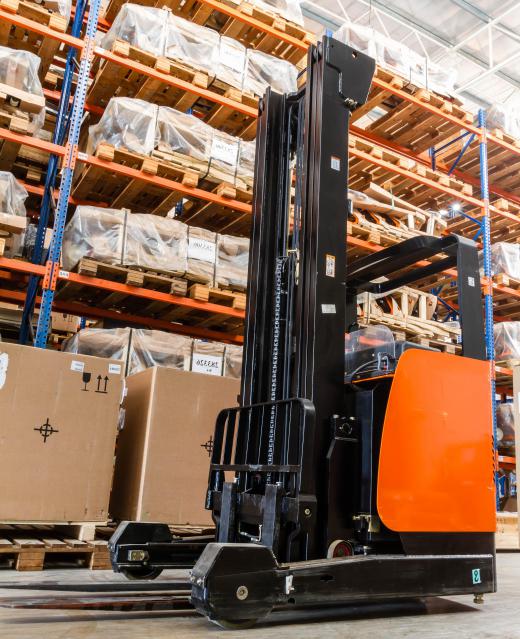The forklift mast is the component on a forklift that the forks ride on when they are raised into the air. Comprised of heavy C-channel steel, the forklift mast is often made up of multiple sections, each interlocking within the other to form a type of vertical conveyor as the hydraulic cylinders raise the load. The forklift mast performs several critical functions on the forklift. First and foremost, the mast provides the vertical support to raise a load into the air on the forks; second, the mast provides protection for the hydraulic cylinders along with the assorted chains and hydraulic hoses that actually operate the lifting components of the forks. Also, the mast is hinged and hydraulically tilts, allowing precision placement of a load when it is positioned on a specific rack or shelf.
The forklift is a type of mobile freight elevator that is used to lift, carry and stack heavy loads of items that are commonly arranged on pallets. With long steel forks that are slid through openings in the pallet, hydraulic cylinders located within the forklift mast are attached to chains, which are fastened to the fork mechanism. As the operator controls the lifting action of the forklift mast from a panel of control levers mounted in the operator's compartment, the forklift is able to raise the pallet high into the air to place the pallet on a rack for storage. The operator will usually drive the forklift forward as far as possible, then the forklift mast is tilted forward to place the pallet as far back as is safe before the operator lowers the forks enough to back the forklift away from the pallet.

Some versions of the forklift have a shift function that allows a hydraulic cylinder, mounted on the forklift mast, to slide the forks horizontally from left to right in order to place pallets of stock as close together as possible to maximize storage space. The forklift mast requires maintenance to ensure the hoses and cylinders are not cut or pinched. The forklift mast typically requires greasing to enable the sections to rise up and down inside of the others without binding.
Another function of the mast is to provide rear stability to the pallet load as it rides in the lowered position on the way to being placed on a rack or another location. Once the forks are lifted, the pallet will typically rise above the height of the mast, having only the short rail attached to the forks for rear stability. This loss of supporting structure of the mast when the forks are raised high is often the grounds for a pallet falling off of the forks and down onto the roof of the forklift. This action is commonly caused by erratic driving by inexperienced operators and cannot only cost a company lots of money in damaged materials, but can severely injure workers.
